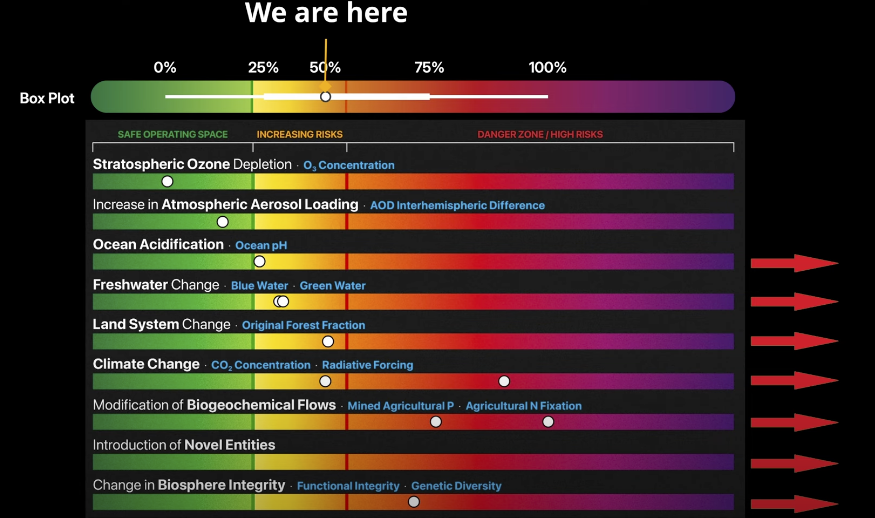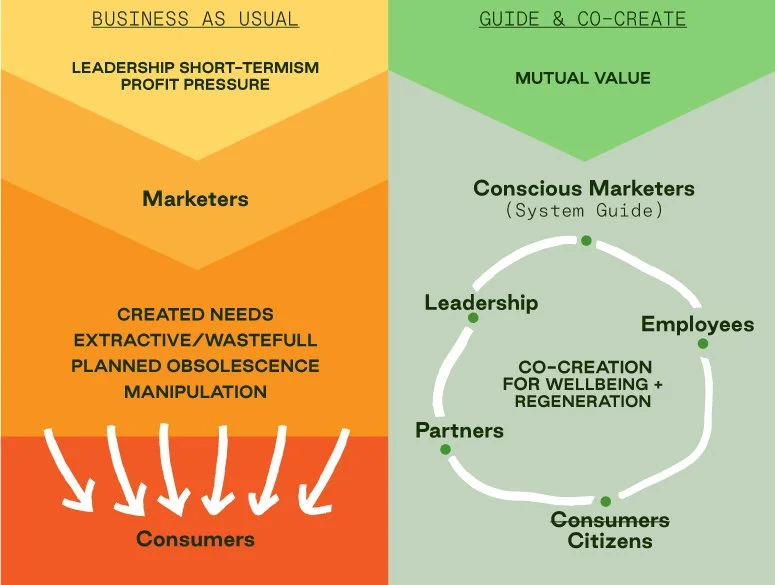What Is Conscious Marketing? (And Why It Matters)
Written By Anne-Marie BrouilletteLet’s pause for a moment—when was the last time you picked a brand not just for what it sold, but because it actually stood for something you care about or truly needed?
As ecological awareness and social responsibility become the new standard—driven by regulations, employee demands, public expectations, lack of resources, and climate change—many of us feel torn: excited by the possibilities, yet held back by fears of change, challenging the status quo, and on top of that, a sprinkle ✨ of eco-anxiety.
This push and pull is part of something bigger: a transition from being consumers to becoming citizens. While consumers prioritize convenience and price, citizens recognize their role within communities and ecosystems, valuing responsibility and meaningful participation over unchecked consumption.
It’s not just about buying; it’s about choosing based on real needs.
This push and pull is part of something bigger: a transition from being consumers to becoming citizens. While consumers prioritize convenience and price, citizens recognize their role within communities and ecosystems, valuing responsibility and meaningful participation over unchecked consumption.
It’s not just about buying; it’s about choosing based on real needs.
So, take five with me here, and let’s explore why conscious marketing matters—and how it’s reframing the way businesses think about success.
How Is Conscious Marketing Different from Traditional Marketing?
Traditional marketing—often referred to as business-as-usual (BAU)—thrives on short-term returns. It encourages disposable consumption, manufactures artificial “needs,” and often downplays social or environmental consequences. It manipulates the sense of identity and self-perception, influencing generations. It’s a direct response to short-term profit pressure in a capitalist “unlimited” growth economy.
Conscious marketing is the opposite of that.
I’m intentionally not using “sustainable” marketing—the term lands as fatiguing and triggers avoidance. I’m using “conscious” marketing instead: it centers decisions—mapping real impacts, being transparent about trade-offs, and designing within planetary and social limits to create long-term value for people, communities, and the living world. It’s not about perfection; it’s about accountable choices and progress you can measure.
The Planetary Boundaries framework is a foundational, science‑based way to understand Earth’s safe operating space. If it’s new to you, this explainer is a great place to start.
Put simply, conscious marketing addresses today’s needs without compromising the ability of future generations to address theirs. Conscious marketing rejects BAU: it replaces short-term extraction with long-term mutual value—it’s a progressive framework that treats people, the planet, and profit as equally important priorities.
It redefines the classic Ps—product, price, place, and promotion—to make decisions that are socially beneficial, environmentally responsible, and economically sound.
Think of it as marketing with a conscience: reformed extractive marketers—or next-generation leaders driving meaningful, people-first strategies.
At its core, it’s part of a transition towards a well-being economy—long, non-linear. I know this will take time; yet, starting now, conscious marketing can guide choices that are transparent, measurable, and designed within social and planetary boundaries.
So why continue to judge a country’s wealth by GDP alone, when real success is reflected in people’s health, the resilience of communities, and the vitality of ecosystems?
Within this vision, economist Kate Raworth’s “doughnut” offers a practical framework: a safe and just space where human needs are met without overshooting planetary limits.
On September 24, 2025, it was officially announced that the ocean acidification boundary had been crossed, marking the seventh of nine planetary boundaries breached. We’re nearing the high‑risk zone for irreversible, irreplaceable damage; adopting a future‑fit framework now is essential.
The focus shifts from extraction to regeneration, from exploitation to empowerment.
This commitment has four key aspects:
Positive Brainprint
Conscious marketing fosters narratives that empower citizens and promote authenticity. Gone are the days of “negative brainprint”—marketing messages that commodify insecurity to create needs. Instead, conscious marketing aims to uplift by championing esteem, health, and purpose, fostering positive societal impacts.
2. Reduced Footprint
Respecting planetary boundaries is central. Conscious marketing ensures through co-creation with stakeholders that products and services minimize harm while innovating for regeneration where possible. That means tracking, disclosing, and reducing impacts across the full lifecycle—from digital emissions (hosting, data, ad delivery) to physical footprints (materials, packaging, logistics, retail, events), including use and end‑of‑life.
3. Radical Transparency
It’s about avoiding all forms of “washing”—green, social, pink, or blue—by leading with transparency and building trust. It means tracking, tracing, verifying, and validating to communicate true, informed claims, while being honest about where you are and where you’re headed.
4. Guide & Co‑create
The ‘guide and co-create’ paradigm, articulated by Dr. Victoria Hurth, flips the script on traditional marketing. Instead of marketers pushing products or just reacting to consumer demand, they become guides—leading with purpose—and collaborators, working hand in hand with citizens and stakeholders.
Conceptual framework adapted from Victoria Hurth, ‘Characterising marketing paradigms for sustainable marketing management, 2017.
Marketing today requires humility and heart—recognizing that marketers shape cultures and social structures, not just sales. By starting where people are and co-creating future-fit solutions, brands move beyond "sell at all costs" tactics. Sustainability becomes a natural thread woven into product design, communications, and operations—not forced or overbranded.
In this new approach, the Chief Marketing Officer (CMO) has evolved from a campaign manager to a purpose-driven leader who champions sustainability. CMOs now work across internal and external teams—product, brand, operations, business and sustainability—to embed sustainability into every aspect of strategy, operations, and storytelling. Their role is critical in turning marketing into a driver of long-term value for both the business and the wider world, rather than just a tool for short-term profits.
This demands creative leadership, a safe and collaborative culture, and bold partnerships to drive the systemic changes needed for a thriving 21st-century economy.
And the best part? It’s not just good karma; it’s good business. Co-creation sparks innovation, builds stronger, authentic relationships, employee motivation and secures long-term success in a world that’s sprinting toward sustainability.
Clearing the Hurdle of Perceived Tradeoffs
Research from Harvard Business Review shows that one of the roadblocks in conscious marketing is the misconception that eco-friendly products require compromises: lower performance, fewer features, or higher prices. Citizens often resist sustainability if they perceive it as inconvenient or inefficient. They are increasingly seeking products that meet their practical, everyday needs. Whether it’s food, clothing, or technology, consumers evaluate three key factors—performance, price, and convenience—while also expecting brands to align with their values. As a result, sustainability should not be treated as a standalone quality; instead, it must become a given—an unseen thread seamlessly woven through products and practices.
Smart brands are actively defying this expectation by demonstrating that sustainable products can be:
More efficient: Energy-efficient appliances that outperform older models.
Longer-lasting: Repairable electronics that reduce lifecycle costs.
Universally accessible: Clever pricing structures or streamlined packaging to make sustainability affordable for all markets.
High-functioning, sustainable products are the future—not because they’re labeled “sustainable,” but because they work better, last longer, are less toxic and create less waste — it meets my needs to be healthy and thriving. Only once a product delivers on its core promise—like powerful cleaning performance, durability, or value for money—does its sustainability story hold real weight. Don’t just tell me you’re using “green” packaging; educate me—tell me it keeps food fresher, longer.
Is This How Growth Gets Future‑Proofed?
Conscious marketing doesn’t just help the planet thrive—it creates powerful opportunities for businesses to thrive—it reflects the direction of our economy and society.
Paul Polman, in his book Net Positive, emphasizes that businesses thrive when they take responsibility for addressing global challenges like climate change and inequality, rather than contributing to them. For Polman, embedding sustainability at the governance level is not just a moral choice, but a strategic imperative for long-term resilience and success.
The earlier businesses start, the stronger their citizen relationships will be, and the more resilient they’ll remain in the face of disruption.
For conscious marketing to succeed, marketing leaders need a seat at the governance table. CMOs act as cross-functional champions—alongside product, business, and brand—connecting innovation, strategy, and culture across the company. ESG isn’t a side quest; it’s integral to the business.
Success looks like this:
Executives understand and embed sustainability at the governance level.
Innovation and brand teams create purpose-driven products and services.
Internal sustainability champions and employees unite behind shared goals and measurable outcomes.
Progress is tracked with quantitative indicators (carbon reductions, waste reductions) and qualitative outcomes (cultural shifts, employee engagement).
Marketing, through a guide‑and‑co‑create approach, helps the organization become a real purpose-driven business.
By embedding the principles of conscious marketing throughout governance and aligning it with purpose, businesses can thrive—achieving long-term success even in a fast-changing world where the economy and climate change impacts life daily.
And yes, it’s already working 🫨
Many companies, both large and small, are already adopting communications and marketing strategies aligned with the principles of sustainable marketing:
Interface
As early as the 1990s, Interface, a flooring company, has rethought its model by introducing circular approaches, including take-back and recycling of its products at end of life, to make access and use easier while closing the loop. It also offers flooring leases as an alternative to purchasing.
Since 1996, the company has published transparent reports detailing its progress and a significant reduction in the carbon footprint of its products. Interface highlights this trajectory through sustainability-focused communications, notably its Climate Take Back mission launched in 2016.
Lego
The toy manufacturer actively communicates its efforts toward circularity and replacing traditional plastic with bio-based materials. Through its educational programs like Build the Change, Lego raises awareness among children about global challenges while encouraging them to come up with creative solutions. The company’s annual impact report also reflects a transparent and educational marketing approach.
Kotn (Canada)
The Canadian ethical clothing brand uses traceability and transparency as pillars of its marketing strategy. Kotn highlights its social impact, such as funding schools in Egyptian cotton-farming communities (where its materials are produced), sharing these stories with a simple and emotional storytelling style.
These brands—whether small, medium, or large—are perfect examples of how authentic communication can be at the heart of their transition toward sustainability. Marketing, as a genuine reflection of their commitments, ensures that every initiative “practices what it preaches.” It remains a central driver of success in their journey.
Each strategy, product, or innovation within these companies is based on one fundamental question:
"Does this align our success with the success of citizens and our planet?"
What if you asked yourself the same question? What could it inspire in you and your colleagues?
Connect with Collective Matter, let’s start with a chat, to explore how your business can lead with purpose and create lasting impact in your industry.
Sources
Hartmann, M., & Mohr, D. (2024). How to Market Sustainable Products. Harvard Business Review.
Cambridge Institute for Sustainability Leadership (CISL). (2025). Sustainable Marketing, communication and brand management.
Raworth, K. (2017). Doughnut Economics: Seven Ways to Think Like a 21st-Century Economist.
Victoria Hurth.(2017). Characterising marketing paradigms for sustainable marketing management.
Polman, P., & Winston, A. (2021). Net Positive: How Courageous Companies Thrive by Giving More Than They Take. Harvard Business Review Press.
New Citizenship Project (2016). CitizenShift Report: A Guide to Understanding and Embracing the Emerging Era of Citizen Power.
https://www.interface.com/content/dam/interfaceinc/interface/sustainability/global/climate-take-back/ctb-primer-presentations/ctb-primer-presentation/pdf/Interface%20CTB%20Primer.pdf
https://www.interface.com/CA/en-CA/sustainability/sustainability-overview.html
https://www.lego.com/en-ca/sustainability/our-commitments
https://www.planetaryhealthcheck.org/







